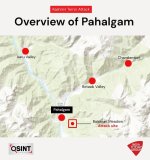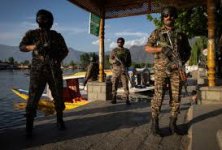The Pahalgam attacks on April 22, 2025, were rooted in a complex mix of terrorism, radical ideology, and geopolitical tensions. Here's a breakdown of the factors that likely led to the attacks:
---
1. Radicalization and Islamist Extremism
The attackers specifically targeted non-Muslim tourists and reportedly asked victims to recite the Islamic kalima, killing those who couldn’t.
This indicates a jihadist motive, influenced by radical Islamist ideology aimed at instilling fear and asserting religious dominance.
---
2. Infiltration by Pakistan-based Terror Groups
Although initially claimed by The Resistance Front (TRF)—a proxy of Lashkar-e-Taiba (LeT)—the claim was later retracted, likely due to the backlash.
Intelligence inputs suggest the attackers infiltrated from Pakistan, possibly with the help of the ISI (Inter-Services Intelligence), indicating state-sponsored cross-border terrorism.
---
3. Deliberate Targeting of Tourism in Kashmir
The attack happened at the start of peak tourist season in Pahalgam, a major contributor to Kashmir’s economy.
Militants likely intended to disrupt the growing peace and normalcy in the region by scaring tourists and reviving the atmosphere of terror.
---
4. Shift in Militancy Strategy
Post-2019 abrogation of Article 370, there had been a decline in organized militancy in Kashmir.
The attack may reflect a strategic shift: from attacking military targets to mass civilian killings, especially religiously motivated ones, to provoke communal unrest and internationalize the Kashmir issue.
---
5. Failure of Local Support Networks
The attackers were well-armed with M4 carbines, grenades, and night-vision gear, indicating logistical support inside Kashmir.
This suggests sleeper cells or radicalized individuals might have aided their movement and shelter.
---
ATTACKS AND RESPONSE , A TIMELINE
A detailed, step-by-step timeline of the events from the April 22, 2025, Pahalgam terror attack to the subsequent ceasefire between India and Pakistan:
---
Five armed militants attacked tourists near Pahalgam in the Baisaran Valley, Jammu and Kashmir. Using M4 carbines and AK-47s, they killed 26 civilians—25 tourists and a local Muslim pony ride operator who resisted the attackers. The assailants targeted victims based on religion, asking them to declare their faith and recite the Islamic kalima. The Resistance Front (TRF), linked to Pakistan-based Lashkar-e-Taiba, initially claimed responsibility but later retracted the claim.
---
In response to the attack:
India suspended the Indus Waters Treaty with Pakistan, a significant move affecting water-sharing agreements.
The Attari-Wagah border crossing was closed, halting trade between the two nations.
All visas issued to Pakistani nationals were canceled, and the SAARC Visa Exemption Scheme was suspended.
India expelled Pakistani military advisers from its High Commission in New Delhi and withdrew its own defense personnel from Islamabad.
Pakistan responded by blocking its airspace for Indian airlines, closing the Wagah border crossing, and suspending all trade with India.
---
Indian security forces launched extensive search operations in Jammu and Kashmir, detaining over 1,500 individuals for questioning.
The United Nations Security Council condemned the attack in the strongest terms and emphasized the need to hold the perpetrators accountable.
---
Prime Minister Narendra Modi granted the Indian armed forces complete operational freedom to respond to the Pahalgam attack, allowing them to choose the mode, timing, and targets for retaliation.
---
India banned all imports from Pakistan and suspended the exchange of inbound mails and parcels via air and surface routes.
Pakistan continued unprovoked firing along the Line of Control (LoC), violating the ceasefire for several consecutive nights.
---
In the early hours of May 7, India launched 'Operation Sindoor,' a precision military operation targeting terrorist launchpads in Pakistan and Pakistan-occupied Kashmir:
Missile strikes were conducted on nine terror targets, including Bahawalpur, a stronghold of Jaish-e-Mohammed.
The Indian Army confirmed the operation, stating, "Justice is Served."
---
On the night of May 8, Pakistan targeted multiple Indian positions in Jammu & Kashmir and Punjab using swarm drones and heavy artillery.
India responded by destroying Pakistan's HQ-9B air defense system in Lahore.
---
A ceasefire was brokered on May 10, reportedly with the diplomatic intervention of U.S. President Donald Trump:
The ceasefire followed intense cross-border fighting that resulted in nearly 70 fatalities, marking the worst escalation in three decades.
India warned Pakistan against violating the ceasefire, stating it would respond to any further infractions.
---
Prime Minister Modi issued a stern warning to Pakistan, asserting that India would resume military action if Islamabad continued to support terrorism.
The ceasefire sparked political debates within India, with some critics arguing that the government capitulated to U.S. pressure, while others supported the decision to prevent further escalation.
---
This sequence of events highlights the rapid escalation and subsequent de-escalation of tensions between India and Pakistan following the Pahalgam terror attack, underscoring the fragility of peace in the region and the complexities of international diplomacy.
---
The Pahalgam terror attacks of April 22, 2025, had far-reaching consequences across multiple domains—security, diplomacy, economy, and public sentiment. Here’s a detailed look at the major effects:
---
1. National Security and Military Response
Heightened security across India, especially in Jammu & Kashmir.
Launch of Operation Sindoor by India on May 7, a retaliatory military strike on terror camps in Pakistan and PoK.
Strengthening of border surveillance, intelligence gathering, and counter-infiltration measures.
---
2. India-Pakistan Diplomatic Fallout
Severe deterioration of India-Pakistan relations:
Suspension of the Indus Waters Treaty by India.
Visa cancellations, expulsion of diplomatic and military attaches.
Trade and airspace closures from both sides.
Near-war escalation followed by a U.S.-brokered ceasefire on May 10.
---
3. Civilian and Economic Impact
Tourism in Kashmir plummeted, with mass cancellations and loss of livelihoods for local guides, pony owners, and hotels.
Emotional trauma among locals—especially as one of the victims was a Muslim Kashmiri who defended tourists.
Businesses in border states like Punjab and J&K suffered due to closure of trade routes and rising tension.
---
4. Communal and Political Repercussions
The religious targeting sparked outrage across India and globally.
Rise in communal tensions, though major violence was avoided.
Political opposition accused the central government of intelligence failure; the government responded with aggressive nationalism.
---
5. International Reactions
UNSC condemned the attack and demanded accountability.
The U.S., UK, France, and other nations supported India’s right to defend itself but urged restraint.
Pakistan faced renewed pressure to crack down on terror groups operating from its soil.
---
6. Long-term Policy Shifts
Push for counter-radicalization programs and stricter internet surveillance in Kashmir.
Increased calls for counter-terror coalitions and action against Pakistan-based groups at international forums.
Proposed legislation to tighten internal security laws and regulate cross-border funding.
---


